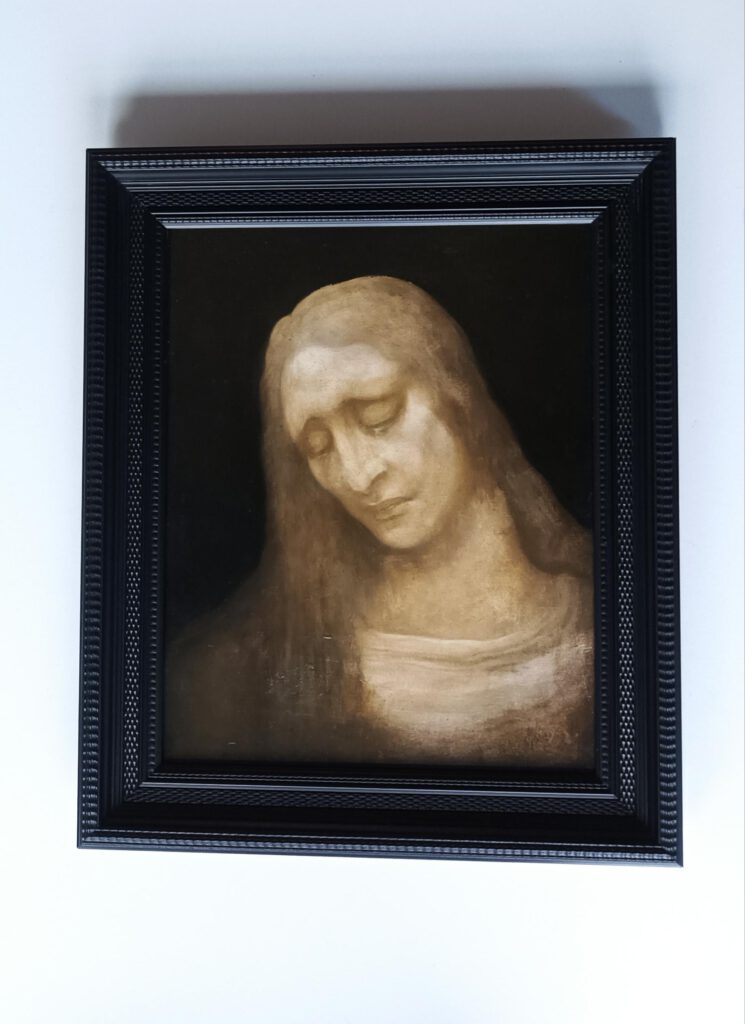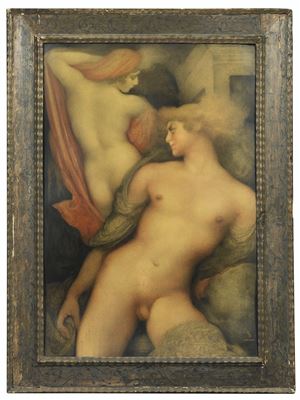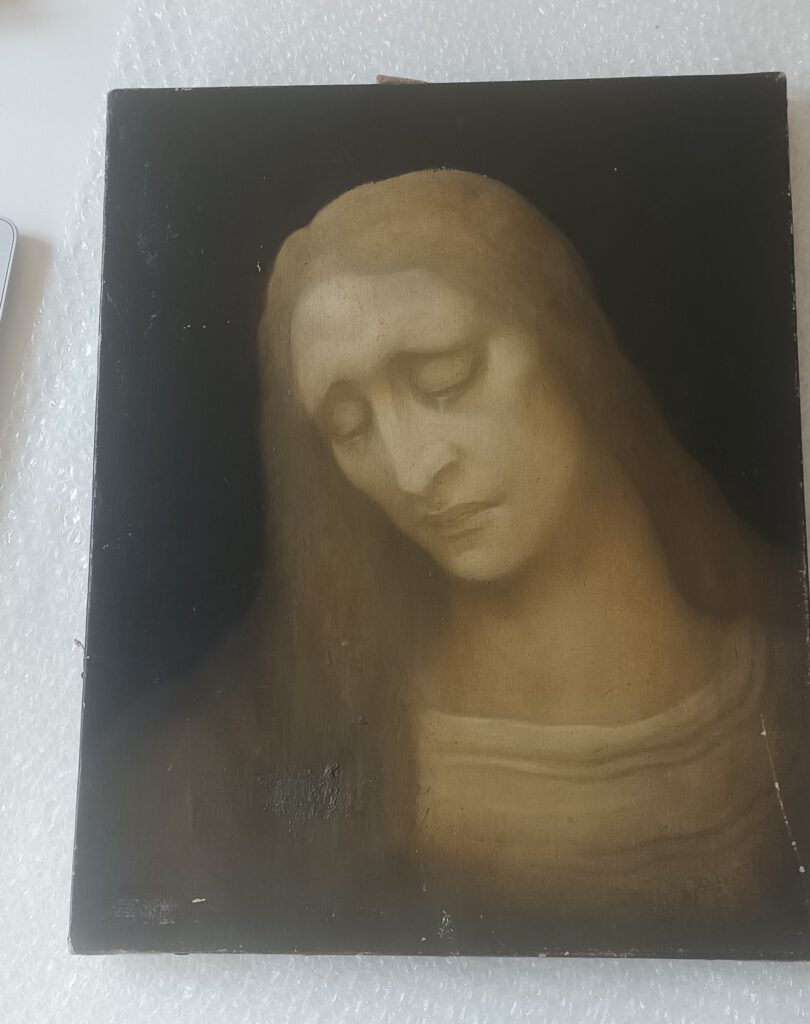
Last year I had the rare chance to buy an oil painting on canvas by Leonard Sarluis for a reasonable price. It was in terrible condition though and had to be cleaned and restored (see the ‘before’ picture at the end of his article). It was unframed, green from nicotine stains, a tear etc.
I found a skilled and experienced restorer who could do it for a reasonable price as well (though I still had to eat lentils for dinner for quite some time). I think it’s a moody masterpiece and it hangs right near my computer, looking at it as I write this. I mean, dude, everybody I show it to loves it, even my weird skater friends! As with all masterpieces, it is very hard to capture its essence/beauty on a mobile phone photo. It has way more subtle fumato as it seems here.
As you might or might not know Sarluis’ paintings are relatively rare. His early work, say before 1910, is almost impossible to find and I guess part of it has just disappeared or has been destroyed, possibly due to its ‘decadence’ (= homosexual themes). For more about Sarluis, see my earlier articles on him (‘Oscar Wilde and his painter friend Leonard Sarluis’, The Oscholars, may 2015, which I can’t find online anymore; ‘Léonard Sarluis’, Pandora Magazine, 2015-II.
Strangely enough, as far as I know, no Dutch museum has any work by this pupil of Breitner, friend of Oscar Wilde, queer and very talented French-Dutch painter. But then again, this is probably not that strange as anything that goes against the (heteronormative, bourgeois) grain has more or less been ignored by the main Dutch museums and collectors of the twentieth century: ‘Doe maar normaal, dan doe je al gek genoeg.’ Beside this work I know of only one more in a Dutch private collection.
My Sarluis measures about 40 x 40 cm. and I call it Weeping Jesus. It could also be Maria Magdalen or Veronica, as this Jesus is like all Sarluis’ figures, quite androgynous. I like the idea of a weeping Jesus, reminds me of the Patti Smith and Depeche Mode and Lee Harvey Oswald Band songs. In the last song particularly Jesus is a ‘fucked up faggot’, taking Jesus as a gay icon to the extremes:
‘J.’ he was an alien, just one of the boys
He had a rock and roll band
He smoked dope daily and
Seen he believed, he
was a miracle man
One day stoned and holy
He was crossing the street
But he didn’t see the cars
With the dent in his head
From the hospital bed he said
‘I’m Jesus from Mars’
And all the little children say,
‘Jesus Never Lived on Mars’
You’re just a fucked up faggot
With a dent in your head
And Jesus never played guitar.
And of course Jesus has more than enough reason to never stop crying. Because of this biblical theme it can probably dated around 1920, when Sarluis worked on a mystical interpretation the bible. ‘Mystical’ being of course androgynous and queer.
The only ‘problem’ with the painting is that it is unfortunately not signed, so officially we would have to say ‘attributed to’. That attribution is confirmed by all Sarluis’ connoisseurs world wide though (all five of them: Andrea L., Florence; Edwin B., Amsterdam; Jean-David J.-L. & Samuel D., Paris; Sander B., Zaandam).

Although I kept doing research on Sarluis – he was, unsurprisingly, good friends with Carel de Nerée – I had not looked in the ever evolving body of Dutch historical texts Delpher for some time. While, in vain, trying to find mention of this particular painting I díd find a text about Sarluis I had not seen before. It is one of the very few more extensive contemporary texts, in Dutch or French, about him. It is written by conservative and moralistic art critic Just Havelaar, who as a young man was apparently very impressed by Sarluis’ work. Ánd it contains a quite explicit reference to Sarluis’ homosexuality, which makes it even more important: ‘The art dealer told me, whispering, marvelous particularities about the painters’ life…’
Yup, that’s not very direct and very much between the lines, but as every queer scholar knows, that’s were you gotta look/read. Havelaars moralistic approach to art is the reason he finally dismisses Sarluis work. I don’t quite understand his conclusion to be honest, but obviously the combination of the holes in Jesus’ body and a hetaere (ancient Greek courtisane) is to be condemned.
Anyway, Havelaars description of his visit to the Rotterdam art dealer is interesting. Havelaar claim that he went there when a schoolboy is probably not correct: Havelaar was born in 1880 and Sarluis in 1874. Sarluis did not exhibited before 1894, so it must have been somewhere in the 1890s. Maybe at the 1894 exhibition at De Driejaarlijksche Tentoonstelling in Rotterdam, at a location unknown to me (art dealer Oldenzeel probably?)
Havelaars article is written on the occasion of a Sarluis exhibition at The Hague art dealer Couvée, October 1919. He just might have met Sarluis there after writing his article, as Sarluis was often in The Hague. One of his good friends there was Frans de Nerée, the younger painter brother of Carel de Nerée who had died in 1909 (source: unpublished letters by Frans de Nerée, private collection). It was published in newspaper Het Vaderland, 28 October 1919. I translated it, so excuse the bad English. Same goes for the article you just read, but I decided to write it in steenkolenengels because abroad there is way more (still not much) interest in Sarluis.

****
I remember having seeing Sarluis’ work when I was still a little schoolboy who once in a while would be allowed to visit a Rotterdam art dealer, a place that to me seemed a wonderful sanctuary. To me, the names Diaz, Rousseau, Millet or Israëls had a legendary ring to them. I could describe many other paintings. But simply devastating was the impression the sheer eastern beauty the paintings of the young genius Sarluis made on me one certain day. That it cértainly was the work of genius was questioned by no one. The art dealer told me, whispering, marvelous particularities about the painters’ life… And he led us behind one of those enormous Rubens and Night Watch imitations, placed in the middle of the back room, to show how the light shimmered through the bright red and yellow: as those masterpieces were painted that thin! From that moment on and for quite some time genius and some sort of diabolical mystery became inseparable to me. A faraway, creepy world opened up to me, one I had never suspected existed. But I didn’t hear his name mentioned for years. I often thought: Sarluis, that gruesome magician, is he dead, murdered perhaps in a harem, poisoned by an Egyptian? And suddenly our compatriot reappears as a hero of the fashionable world in Paris. A great critic wrote great words about the great artist, apparently misunderstood by his provincial compatriots. Three of his paintings and numerous drawings are now on view at the Couvée gallery. The barbarian splendor has been exchanged for sultry sensualism. He depicts women as young men and young men as women, whose desirable physical beauty has been poeticized into a sentimental and concealed eroticism. A cold, lifeless voluptuousness veils itself in the false appearance of the most vile romanticism. Our grossest and bases selfish instincts here envelop us in a masquerade of spirituality… Unsurprisingly, the modern world of luxury, with its snobbery, its sensual coquetry, its falsification of feeling and its complete mindlessness, covets either the brutal and cynical barbarism of Jan Sluijters Negress, or the sentimental perversity of Sarluis. It gives one hope that Sarluis’ expression must remain crude to such an extent and remains a blunt imitation of the Italian decadence of Leonardo. Even the faded discoloration of the Italians’ paintings caused by time were duly imitated. They are bad oleographs after very murky imitations of Da Vinci and Titian. The drawings, heavy with allegorical literary intentions, reveal all the painters technical limitations. The spirit remains the same though. When Abraham wants to sacrifice his child, a manmade hetaere appears to him, who shows Christs wounds on hands, feet and side: one understands the deeper meaning…

